Concrete patios are often seen as the underappreciated backbone of backyard design, overshadowed by their natural stone and wood counterparts. Yet, they carve their niche with unmatched versatility and durability. This unique character sets them apart in the world of outdoor spaces, offering a distinct experience that distinguishes concrete patios as a category in their own right.
Key concrete patio design ideas include Stamped Concrete, Stained Concrete, and Polished Concrete, each known for its unique aesthetics. Exposed Aggregate Finish also stands out, offering patio lovers a textured but sophisticated choice. Ace Concrete Contractors Austin—Slabs, Driveways, Patios, and Sidewalks provide expert services for creating these stunning concrete patio designs, ensuring beauty and longevity. Each type of concrete patio design presents its aesthetics, maintenance needs, installation techniques, historical significance, and recommendations for complementary landscaping.
The following sections will explore these aspects in detail, providing a richer understanding of what makes concrete patios versatile and durable for enhancing outdoor living spaces worldwide.
Why choose concrete for your patio?

Choosing concrete for your patio brings two main benefits: durability and versatility. Concrete stands up against time and weather, making it a long-lasting choice for any backyard. Its versatility shines through in the ability to mimic other materials like natural stone and wood, offering a wide range of design possibilities.
Concrete can be tailored to fit your vision, whether aiming for a natural look with earth tones or a modern feel with bold colors. This adaptability extends to various finishes and styles, from the sleek polish of a high-gloss surface to the rustic charm of exposed aggregate. With concrete, your patio can quickly become a central feature of your backyard, blending functionality with aesthetic appeal.
Durable and long-lasting
Concrete patios are renowned for their exceptional durability. They can endure extreme weather conditions, from summer’s scorching heat to winter’s icy grip, all while resisting joint deterioration seen in less robust materials. A concrete patio can last for 30 to 40 years or more with proper installation and maintenance, significantly outlasting wood decks, which have a lifespan of about 10 to 15 years. Concrete patios can also be more durable than pavers, which may shift or crack over time.
This steadfastness ensures that your outdoor space remains beautiful and functional for decades, positioning concrete as a cost-effective and reliable option for any exterior setting.
Versatile in design
The versatility of concrete opens up a world of design possibilities unmatched by any other patio material. With the ability to be shaped, colored, and textured, concrete can effortlessly imitate materials such as natural stone, brick, and wood. Techniques like stamping and staining allow for the creation of patios that mimic cobblestone, slate, flagstone, or wood grain textures, offering a custom look that can fit any landscape design.
Polished and exposed aggregate finishes provide unique aesthetics that complement a modern, minimalist look or a more traditional, rustic charm. This adaptability empowers homeowners to realize their specific aesthetic visions without sacrificing the inherent benefits of concrete. Whether the goal is to create a sleek, contemporary look or evoke a cozy, rustic ambiance, concrete’s diverse design capabilities can accommodate any preference or style, making it a superior choice for homeowners who customize their outdoor living spaces.
Stamped Concrete Patios
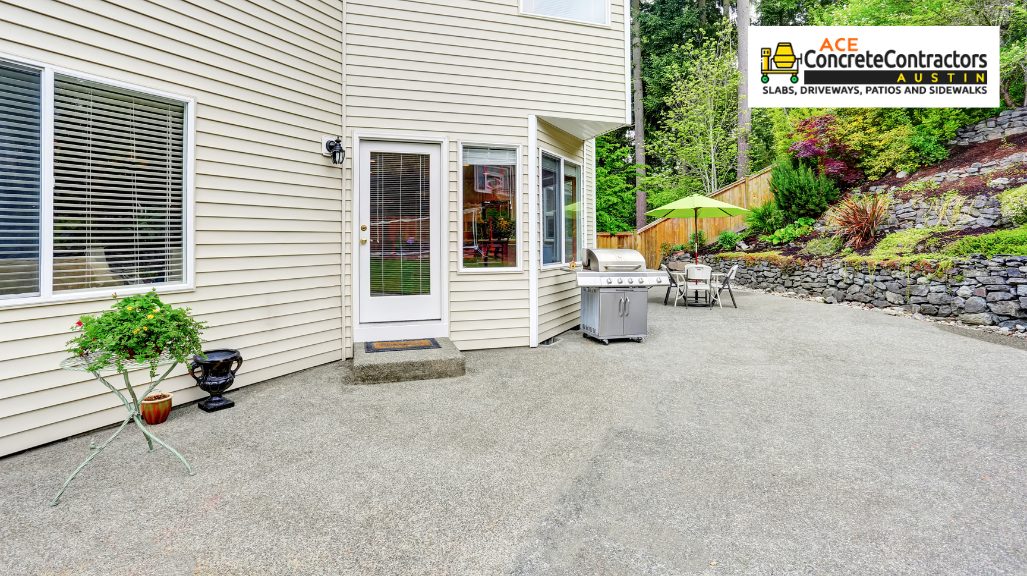
Stamped concrete patios are a testament to concrete’s innovative versatility and unmatched durability for enhancing outdoor spaces. This method involves imprinting patterns into the freshly poured concrete, creating textures and designs that mimic various natural materials. Homeowners have the luxury of choosing from looks that resemble natural stone, brick, or even wood, but with the added advantages of easier maintenance and often lower costs.
The ability to customize patterns and colors offers a personalized touch, making each stamped concrete patio a unique reflection of individual style and preference. Whether the goal is to achieve the sophisticated elegance of stone or the warm, inviting ambiance of wood, stamped concrete patios deliver a durable, attractive, and cost-effective solution for any backyard transformation.
Mimicking natural stone and wood & Custom patterns and colors
Pattern Type | Real-World Example | Color Combination | Description |
Slate | Mountain Retreat | Charcoal & Slate Gray | Mimics the elegant, layered look of natural slate, perfect for rustic and traditional designs. |
Cobblestone | Old Town Charm | Sandstone & Burnt Sienna | Offers the quaint, cozy feel of a European village with its varied shapes and warm tones. |
Wood Plank | Lakeside Getaway | Cedar & Walnut | Replicates the linear grain of wood planks, bringing a natural, warm ambiance to lakeside homes. |
Flagstone | Garden Pathway | Moss Green & Earth | Creates the irregular shapes and textures of flagstone, ideal for garden paths and cottage styles. |
Brick | Colonial Elegance | Brick Red & Charcoal Highlight | Emulates traditional brickwork, lending a timeless appeal to colonial and classic home exteriors. |
Ashlar Slate | Modern Minimalism | Silver & Light Gray | Features the geometric precision of cut slate, suited for sleek, contemporary patio designs. |
Stained Concrete Patios
Stained concrete patios introduce a dynamic spectrum of color to outdoor spaces, embracing an array of hues that can elevate the aesthetic of any backyard. This technique embeds concrete with rich, enduring tones through a deep-penetrating stain, ensuring a durable and fade-resistant finish. Whether opting for the subtle harmony of earth tones that meld with the garden’s natural palette or choosing vibrant, eye-catching colors for a modern twist, stained concrete allows for a high degree of personal expression in outdoor design.
The inherent versatility of staining methods ensures that each patio is a bespoke masterpiece tailored to reflect the homeowner’s style preferences while leveraging the practical advantages of concrete.
Earth tones for a natural look & Bright, bold colors for a modern feel
Shade/Color | Type | Ideal Use | Description |
Terracotta | Earth Tone | Mediterranean & Rustic Themes | Mimics the warm, reddish-brown hues of traditional terracotta tiles, perfect for creating a cozy, inviting outdoor space. |
Sandstone | Earth Tone | Natural Landscape Integration | Offers a soft, neutral base that complements natural landscaping, ideal for serene garden patios. |
Moss Green | Earth Tone | Garden Patios | Blends seamlessly with lush greenery, enhancing the garden’s natural beauty and creating a tranquil retreat. |
Azure Blue | Bright, Bold Color | Contemporary & Poolside Patios | Evokes the clear blue of the sky and water, adding a vibrant splash of color to modern designs. |
Fiery Red | Bright, Bold Color | Energetic, Dynamic Spaces | Captures attention with its boldness, infusing patios with energy and a strong visual impact. |
Lush Green | Bright, Bold Color | Eclectic & Bohemian Themes | Brings a lively, verdant feel to outdoor spaces, encouraging a connection with nature in urban settings. |
Polished Concrete Patios

Polished concrete patios epitomize the fusion of sleek, modern elegance with concrete’s inherent strengths, offering an outdoor space that dazzles with its high-gloss finish. This design choice not only elevates the patio’s visual appeal but also bolsters its durability and ease of maintenance. The reflective nature of a polished surface maximizes the impact of both natural and artificial light, creating a bright and welcoming environment.
Its minimalist style perfectly matches contemporary outdoor living areas, aiming for a sophisticated yet understated look. The customization possibilities with polished concrete are extensive, allowing for a range of sheen levels and incorporating decorative elements like aggregates or dyes, offering a truly unique aesthetic. This adaptability ensures that each polished concrete patio can be precisely tailored to fit the homeowner’s vision, making it an ideal choice for those looking to blend functionality with personalized style in their backyard oasis.
High gloss for a sleek finish & Minimalist style for contemporary designs
Process/Element | Description | Complementary Design Elements |
Grinding and Polishing | The concrete surface is mechanically ground and polished to achieve a high-gloss finish. Diamond-segmented abrasives of increasing fineness are used to smooth the concrete to the desired gloss. | Minimalist furniture, geometric patterns, and monochromatic color schemes enhance the sleek look. |
Sealants | After polishing, a concrete densifier is applied to harden the surface, followed by a sealant to create a high-gloss finish. This sealant enhances the shine and protects the surface from stains and weathering. | LED lighting, glass elements, and metal accents work well with the reflective surface, adding to the modern aesthetic. |
Aggregate Exposure | During the polishing process, varying degrees of aggregate exposure (from none to full exposure) can be achieved by adjusting the grinding depth. This adds visual texture and interest to the minimalist design. | Natural wood, greenery, and soft textiles provide warmth and contrast to the complex, polished surface. |
Color Integration | Stains or dyes can be applied during the polishing process to add color to the concrete, ranging from subtle hues to vibrant tones. This allows for customization to fit any minimalist color palette. | Colorful outdoor rugs, cushions, and art pieces can add pops of color while maintaining a clean, minimalist look. |
Exposed Aggregate Finish
An exposed aggregate finish elevates concrete patios by revealing the raw beauty of materials like stone, pebbles, and sand embedded within the concrete. This technique imparts a unique, textured appearance and significantly improves slip resistance, making it an ideal choice for outdoor settings. The diversity in the materials that can be exposed offers endless possibilities for customization, allowing homeowners to craft a patio surface that perfectly aligns with their home’s aesthetic and the surrounding landscape.
Beyond its visual appeal, exposed aggregate is celebrated for its durability and low maintenance. It can withstand extreme weather and everyday use rigors. This blend of beauty, practicality, and longevity positions the exposed aggregate finish as a favored option for those seeking to infuse their outdoor spaces with character and resilience.
Textured surface for slip resistance & Varied color options for unique looks
Process/Feature | Aggregate Material | Color Options | Slip Resistance | Description |
Surface Preparation | N/A | N/A | N/A | The concrete surface is poured and smoothed. Then, the top layer is partially removed to expose the aggregate beneath. |
Aggregate Exposure | Pebbles, Stones | Natural Earth Tones, Grays | High | Due to their textured surface, pebbles and stones offer a natural look with high slip resistance. |
Aggregate Exposure | Crushed Glass | Blues, Greens, Reds | Moderate | Crushed glass can add vibrant colors and a unique sparkle to the surface, with moderate slip resistance. |
Aggregate Exposure | Colored Stones | Varied, Customizable | High | Colored stones can match or contrast the home’s exterior, offering customizable aesthetics with high slip resistance. |
Sealing | N/A | N/A | Enhances | After exposure, the surface is sealed to protect against weather and wear, slightly enhancing the slip resistance by locking in the aggregate. |
Maintenance | N/A | N/A | N/A | Regular cleaning and resealing every few years maintain the appearance and functionality of the exposed aggregate surface. |
Next Up: 7 Important Questions to Ask Your Concrete Contractor
Concrete Pavers
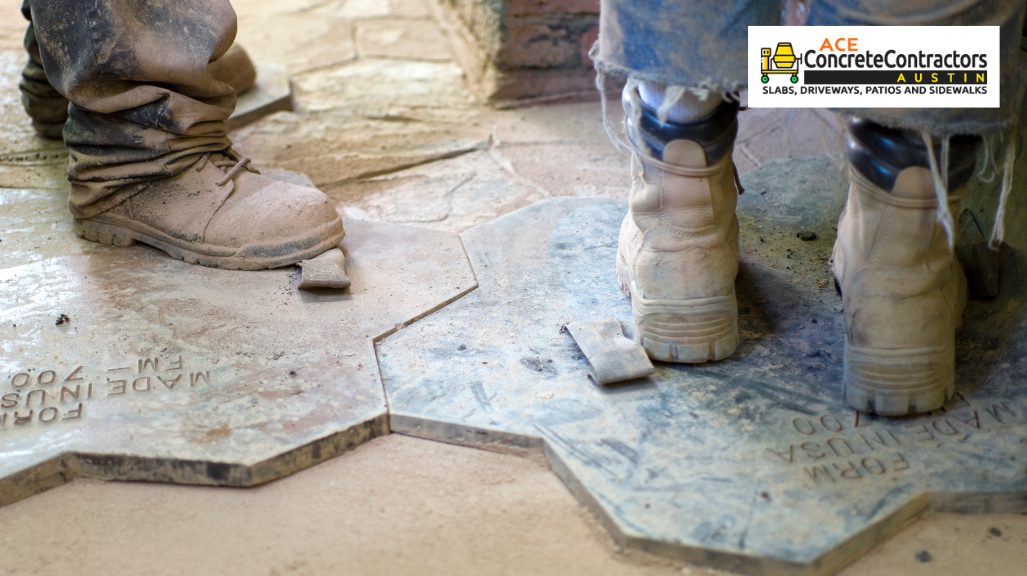
Concrete pavers present a versatile and aesthetically appealing solution for crafting standout patios. Renowned for their durability and ease of maintenance, these pavers are available in various shapes, sizes, and colors, facilitating limitless creative possibilities. Concrete pavers offer the flexibility needed to realize any design vision, whether to achieve a time-honored look with classic patterns or to innovate with a unique, bespoke layout.
Their interlocking design not only simplifies installation but also enhances the overall stability and longevity of the patio structure. Moreover, the convenience of replacing individual pavers quickly adds a practical advantage, ensuring that keeping your patio in pristine condition is both straightforward and efficient. Opting for concrete pavers means embracing a blend of functionality and style, solidifying their status as a favored choice for elevating outdoor living spaces.
Interlocking patterns for easy installation & Various shapes and sizes for creative designs
Pattern Name | Shape & Size | Installation Ease | Visual Appeal | Ideal Use |
Herringbone | 6″x12″ rectangles | Moderate | High | Driveways, Patios, Walkways |
Basketweave | 6″x6″ squares, 12″x12″ squares | Easy | Moderate | Patios, Paths |
Running Bond | 4″x8″ rectangles | Easy | High | Walkways, Patios |
Circular | Varied, including wedge shapes | Challenging | High | Patios, Focal Points |
Fan | Specialized fan-shaped pavers | Moderate | High | Patios, Decorative Areas |
Cobblestone | Varied, irregular shapes | Moderate | High | Old-World Charm Patios, Walkways |
Adding a Fire Pit
Incorporating a fire pit into your concrete patio transforms the area into a captivating focal point of warmth and social gathering. This addition not only boosts the aesthetic allure of your outdoor space but significantly increases its functionality, inviting cozy evenings of entertainment and relaxation. Whether you choose a built-in fire pit that melds seamlessly with your patio’s overall design or a portable fire pit for flexible use, the presence of a fire element creates an inviting ambiance that can make your patio enjoyable year-round.
The wide range of styles and materials available for fire pits allows for complete customization, ensuring a perfect match with your patio’s theme, be it rustic charm or modern sophistication. Adding a fire pit is more than just a design choice—it’s about crafting memorable moments and enhancing the quality of outdoor living.
A central gathering spot for entertainment
A fire pit acts as the central gathering spot for entertainment, magnetically drawing guests together into a circle of warmth and camaraderie. Designing a fire pit area that encourages social interaction can significantly enhance the enjoyment and functionality of your outdoor space. Consider the following ideas and tips for creating an inviting fire pit area:
- Circular Seating Arrangements: Arrange seating in a circle or semi-circle around the fire pit to foster conversation and ensure everyone feels included.
- Built-in Seating: Incorporate built-in benches or seating walls to provide ample and permanent seating options for guests.
- Comfortable Furnishings: Choose comfortable chairs and cushions that invite guests to relax and stay awhile.
- Adjustable Lighting: Install adjustable lighting around the fire pit area to complement the fire’s glow and create the right ambiance for every occasion.
- Safety Considerations: Ensure enough space between the seating and the fire pit to keep guests safe from sparks or flames.
Warmth and ambiance for evening gatherings
The type of fire pit you choose—whether gas, wood-burning, or propane—can significantly affect the ambiance of your patio space. Each type has its unique characteristics:
- Wood-burning fire Pits Offer a traditional campfire experience, with the crackling sound of burning wood and the smoky aroma. They are ideal for creating a rustic and cozy atmosphere.
- Gas Fire Pits Provide convenience and cleanliness, with easy ignition and no smoke. They also allow for a sleek and modern design, fitting well with contemporary patio styles.
- Propane Fire Pits: Similar to gas fire pits in cleanliness and ease of use, propane models offer portability and flexibility in placement, as they don’t require a gas line connection.
Each fire pit type brings charm and ambiance to your outdoor gatherings. Wood-burning fire pits evoke a sense of nostalgia and natural beauty, while gas and propane fire pits offer a more controlled and clean-burning option, suitable for modern outdoor living spaces.
Incorporating Water Features
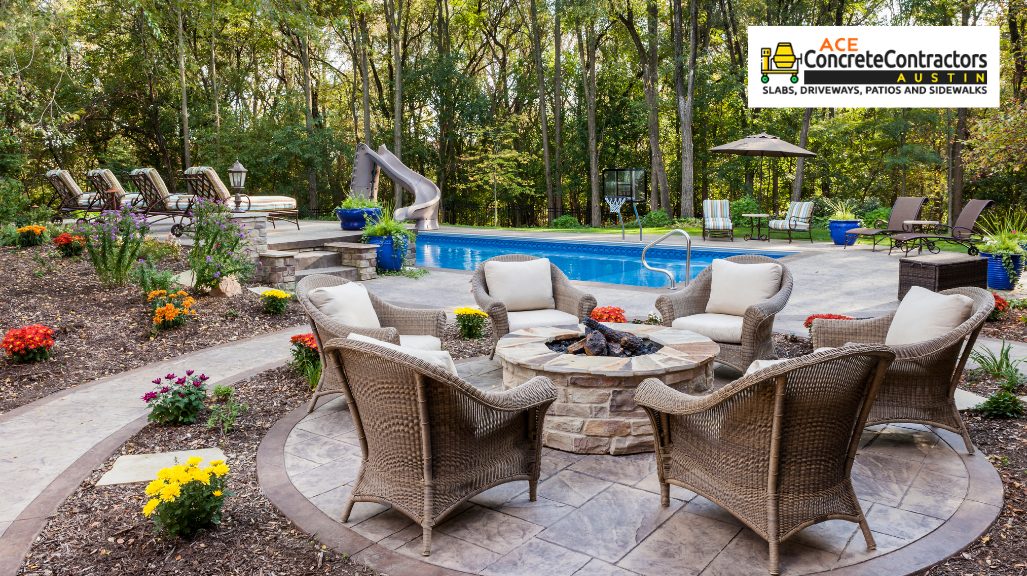
Adding water features to your concrete patio introduces a layer of serenity and dynamic appeal to your outdoor sanctuary. The soothing sounds of water contribute to a tranquil atmosphere, converting your patio into a peaceful haven. From the elegance of flowing fountains to the simplicity of reflective ponds, water features can be tailored to complement any patio size or design preference, infusing your space with visual charm and a calming ambiance.
Whether it’s the subtle murmur of a tabletop fountain or the serene expanse of a small pond, integrating water into your patio design significantly enhances the sensory experience of your outdoor area. This addition not only boosts the aesthetic value of your patio but also creates a central point of relaxation and reflection, transforming your backyard into an oasis of tranquility.
Fountains for soothing sounds
Fountains play a pivotal role in crafting a serene patio ambiance, offering the soothing sounds of flowing water that envelop the space in a cocoon of tranquility. Specific types of fountains well-suited for patio environments include:
- Wall Fountains: Ideal for smaller patios or as a space-saving solution, wall fountains add a vertical element of interest and the gentle sound of cascading water.
- Tiered Garden Fountains: These classic fountains serve as a stunning focal point, with multiple levels allowing for the delightful sound of water trickling from one tier to another.
- Spillway Bowls: Modern and sleek, spillway bowls feature water overflowing from one bowl to the next, creating a visually striking effect and soothing sound.
- Tabletop Fountains: Perfect for intimate patio settings, tabletop fountains offer a personal and portable water feature option that can be placed on outdoor dining tables or side tables.
Small ponds for a natural oasis
Integrating a small pond into your patio design invites the essence of a natural oasis right into your backyard. Here are some considerations for incorporating a small pond:
- Location: Choose a spot that receives adequate sunlight if you plan to include aquatic plants. Ensure the area is stable and can support the weight of a pond.
- Size and Depth: Determine the size based on your available space and intended use, such as fish habitation or purely ornamental. A depth of 18-24 inches is suitable for most small ponds.
- Lining: To contain the water, use a flexible liner or a preformed pond shell. Ensure it is durable and puncture-resistant.
- Filtration and Aeration: If you plan to keep fish, include a filtration system to keep the water clean and an aerator or fountain to maintain oxygen levels.
- Plants and Wildlife: Add aquatic plants for natural filtration and aesthetic appeal. If you wish to introduce wildlife, consider fish species that thrive in your climate.
- Maintenance: To keep the pond healthy and attractive, regularly check the water level, clean the filter, and remove debris.
Incorporating water features such as fountains and ponds into your concrete patio design enhances the beauty and ambiance of your outdoor living space. It creates a tranquil retreat for relaxation and enjoyment.
Built-in Seating
Incorporating built-in seating into your concrete patio elevates your outdoor space’s aesthetics and utility. This permanent solution integrates flawlessly with the patio’s design, offering a unified and stylish appearance. Built-in benches or seating walls provide ample space for relaxation and gatherings and enhance the patio’s functionality by eliminating the need for additional furniture, thus freeing up more space for enjoyment.
These features can double as storage solutions or help define different areas within the patio, adding layers of convenience and sophistication to your design. The robust nature of concrete guarantees that this seating arrangement withstands time and weather, maintaining its comfort and welcoming appeal for years. With built-in seating, your patio becomes a more versatile and inviting extension of your home, reflecting your style while improving the overall ambiance of your outdoor living environment.
Permanent benches for reliable seating
Permanent benches constructed from concrete offer a steadfast and reliable seating solution for your patio, contributing to the space’s aesthetic consistency. When integrating permanent benches into your patio layout, consider the following materials and design considerations:
- Materials: High-quality concrete is the primary material known for its durability and versatility. For added comfort, incorporate weather-resistant cushions or wooden seat tops.
- Design Considerations: The design of your benches should complement the overall style of your patio. Curved benches can add an organic feel to the space, while straight, angular benches may suit a more modern aesthetic.
- Placement: Position benches to take advantage of views or to create intimate seating areas. Consider the flow of movement around the patio to ensure the benches enhance the usability of the space.
- Functionality: Built-in benches can also serve as retaining walls or be designed with hidden storage underneath for cushions and outdoor accessories.
Concrete planters as seats for dual functionality
Concrete planters that double as seating are a testament to the innovative and versatile use of space in patio design. Here are examples of how concrete planters can be designed to serve dual purposes:
- Planter Bench Combos: Integrate linear planters with wooden bench tops that span the planters’ length, providing a seamless transition from greenery to seating.
- Circular Planter Seats: Design circular concrete planters with a wide, flat rim, allowing them to function as informal seating around the planter’s perimeter.
- Modular Planter Blocks: Use modular concrete blocks that can be stacked to create custom planter shapes. Flat-topped blocks can serve as seats or side tables.
- Integrated Design: For a cohesive look, design planters and seating to match or complement each other in texture, color, and style. This approach beautifully ties the entire patio space together.
Incorporating built-in seating and dual-purpose concrete planters into your patio design maximizes functionality and adds unique aesthetic appeal. These elements create inviting outdoor living spaces that encourage relaxation and social interaction, making your patio an enjoyable retreat for family and guests.
Outdoor Kitchens on Concrete Patios
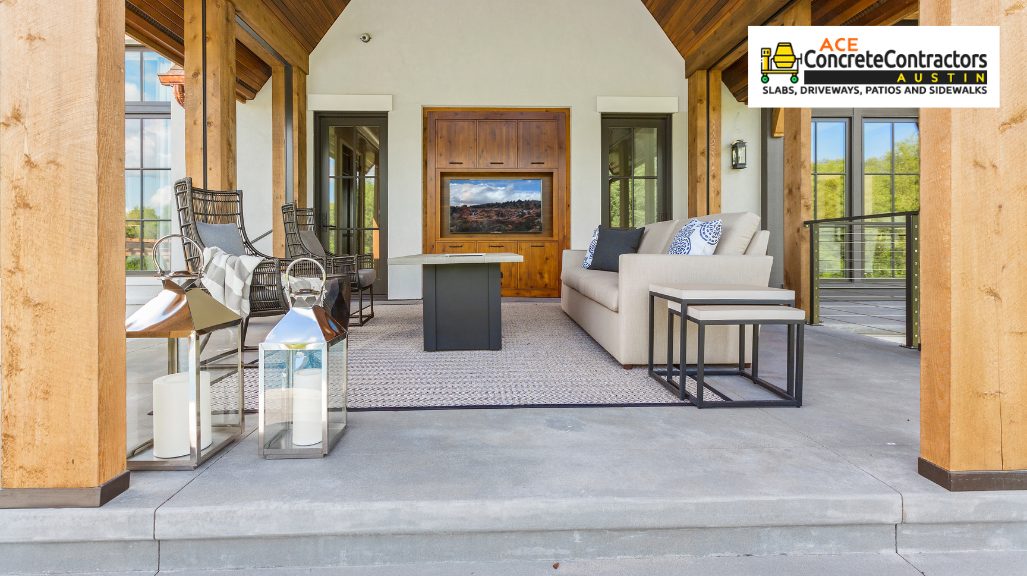
Outdoor kitchens on concrete patios elevate the experience of al fresco dining by blending the practicality of a fully functional cooking area with the natural beauty of the outdoors. Concrete, celebrated for its durability and versatility, is an ideal foundation for these culinary havens, capable of enduring both weather and the rigors of cooking activities. Whether you desire a modest grilling station or a lavish kitchen ensemble complete with sinks, refrigerators, and countertops, concrete patios can tailor your outdoor kitchen to your specific desires and entertaining needs.
This enhancement not only boosts the functionality of your outdoor space but also adds significant value to your home by introducing a sought-after amenity that promises unforgettable gatherings. An outdoor kitchen on a concrete patio transforms ordinary backyard meals into extraordinary dining experiences, inviting a deeper appreciation for the joys of outdoor living.
Grilling stations for BBQ enthusiasts & Full kitchen setups for outdoor dining
Component | Grilling Station Essentials | Material Choices | Full Kitchen Setup Elements | Spatial Considerations |
Grill | High-quality BBQ grill | Stainless steel for durability and resistance to high temperatures | Integrated gas or charcoal grill, possibly with additional burners | Adequate space for the grill size, with proper ventilation |
Countertops | Prep and serving areas | Heat-resistant materials like granite or glazed concrete | Expansive countertops for food preparation and serving | The layout that allows easy access between the grill, sink, and storage |
Storage | Cabinets for tools and accessories | Weather-resistant wood, stainless steel, or polymer | Cabinets and drawers for utensils, cookware, and pantry items | Strategic placement for efficient workflow and accessibility |
Sink | Optional for basic stations | Stainless steel or stone | Full-size outdoor sink with hot and cold water | Close to the prep area for convenience, with proper plumbing considerations |
Refrigeration | Optional cooler or mini-fridge | Stainless steel exterior for outdoor use | Full outdoor refrigerator or wine cooler | Positioned for easy access without interfering with cooking zones |
Lighting | Task lighting over grill area | Weather-proof fixtures | Comprehensive lighting plan, including task, ambient, and accent lighting | Evenly distributed to illuminate all areas, avoiding shadows |
Seating | Bar stools or standing space | Durable outdoor materials | Integrated seating areas or bar-style seating | Ample space for guests to gather without crowding the cooking area |
Integrating Lighting
Integrating lighting into your concrete patio design enhances safety by illuminating paths and steps and significantly elevates the ambiance of your outdoor space after sunset. Strategic placement of lights can accentuate architectural features, beautifully landscaped areas, and key gathering spots, creating an enchanting nighttime environment. The options are versatile and dynamic, from embedded LED lights within the concrete, offering a sleek, modern look, to solar-powered path lights that provide an eco-friendly lighting solution.
Dramatic spotlighting can also highlight specific elements, adding depth and interest to the patio design. This thoughtful integration of lighting transforms your patio into a multifunctional space, perfect for evening entertainment and relaxation. It extends the usability and enjoyment of your outdoor area well into the night.
Embedded lights for safety and ambiance & Solar path lights for eco-friendly illumination
Lighting Type | Installation Process | Benefits | Use Cases | Additional Features |
Embedded LED Lights | Installed during the concrete pouring process or retrofitted into existing concrete via cutouts. Wiring is run beneath the surface, and lights are sealed to protect against moisture. | It provides a seamless look that enhances safety by illuminating walkways and steps. It also adds a modern aesthetic to the patio. | Highlighting architectural features, illuminating paths, and creating ambiance for outdoor living areas. | It can be connected to smart home systems for automated control. Available in various colors for dynamic lighting effects. |
Solar Path Lights | Easily installed by staking into the ground along pathways or around patio perimeters. Solar panels on the lights charge during the day and automatically illuminate at night. | They are eco-friendly and cost-effective, requiring no wiring and using renewable solar energy. They are also easy to install and relocate if needed. | Lighting walkways, garden borders, and patio edges for enhanced safety and visual appeal. | It is often equipped with sensors for automatic operation from dusk to dawn and is available in various styles to match outdoor decor. |
Landscaping Around Your Concrete Patio
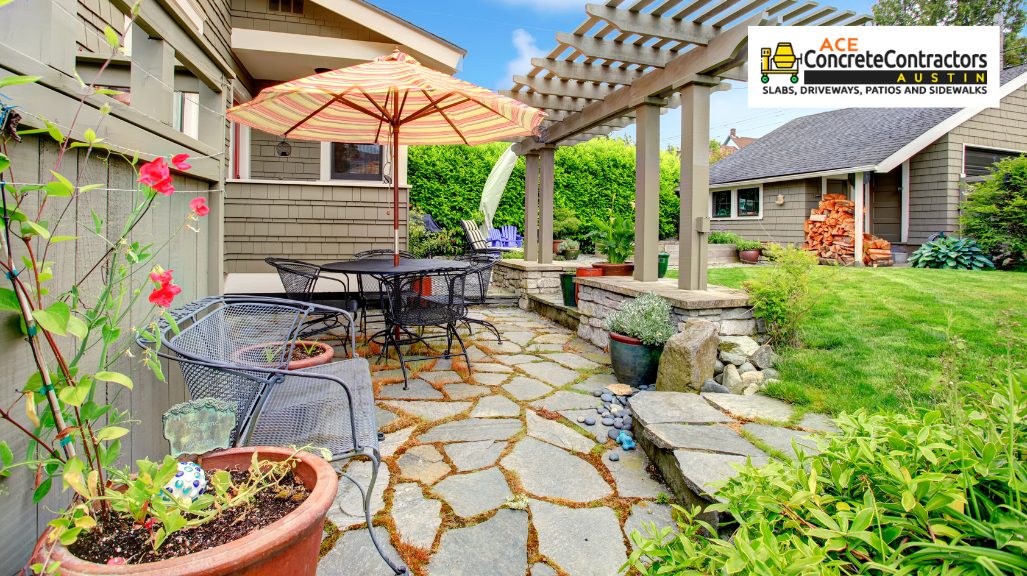
Landscaping around your concrete patio elevates its visual appeal and fosters a seamless integration with the natural surroundings. Thoughtfully selected plants can introduce color, texture, and fragrance, transforming the space into a more inviting and serene haven. Incorporating vibrant flower beds can attract pollinators, while lush shrubs offer privacy and shade, enhancing the usability and comfort of your outdoor living area.
The addition of trees and water features not only adds to the beauty and diversity of the landscape but also enriches the patio with soothing sounds and cool shade, creating a perfect backdrop for relaxation and entertainment. This harmonious blend of hardscape and softscape elements ensures your patio becomes an extension of your indoor living space, where the boundaries between inside and outside blur into a cohesive and tranquil retreat.
Flower beds for color and fragrance
Flower beds enveloping your concrete patio bring a burst of color and fragrance, dramatically elevating the space’s charm and allure. These natural tapestries add visual interest and transform the patio into a more welcoming and enjoyable area. By choosing a variety of species that bloom at different times, you can ensure a continuous display of beauty and scent, making your patio a year-round haven for relaxation and delight.
Shrubs and trees for privacy and shade
Integrating shrubs and trees around your concrete patio offers essential privacy and shade, significantly enhancing the comfort and seclusion of your outdoor living space. These living screens protect against the elements and curious glances, creating a serene and calm oasis even on the hottest days. Beyond their practical benefits, shrubs and trees contribute to the landscape’s visual depth and structure, enriching your backyard retreat’s overall aesthetic and tranquility.
Frequently Asked Questions
What are some popular concrete patio design ideas for small backyards?
For small backyards, stamped concrete designs that mimic natural stone or brick can add depth and elegance. Incorporating a border in a contrasting color also visually expands the space, and geometric patterns can create the illusion of more room.
How can lighting enhance the ambiance of a concrete patio?
Strategically placed lighting can transform a concrete patio into a cozy evening retreat. LED lights embedded along the edges or solar lights integrated into the landscaping around the patio can highlight its design and ensure safety.
What are the benefits of choosing concrete for a patio over other materials?
Concrete offers unparalleled durability and versatility. Homeowners can customize the look through stamping, staining, and molding. Concrete patios require less maintenance than wood decks and can withstand harsh weather conditions better than pavers.
How does staining concrete patios add to their aesthetic appeal?
Staining allows homeowners to add vibrant colors or subtle hues to their concrete patios, creating a unique look. Acid stains react with the concrete for a marbled effect, while water-based stains offer a wide range of solid colors.
What maintenance is required to keep a concrete patio looking its best?
Dirt and grime can be removed by regular cleaning with a mild detergent and a stiff brush. Sealing the concrete every few years protects against moisture and wear, preserving the patio’s appearance and extending its lifespan.
